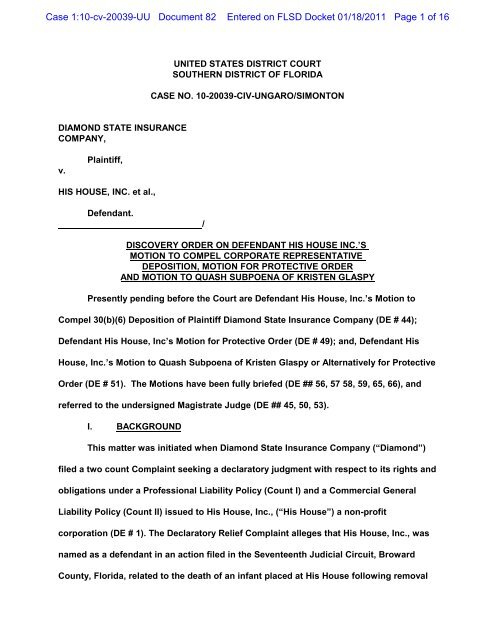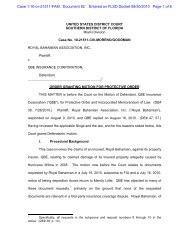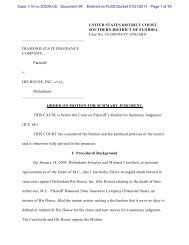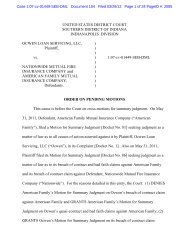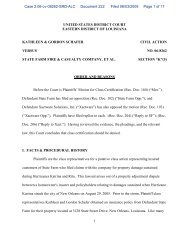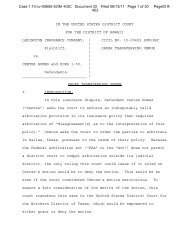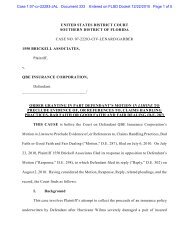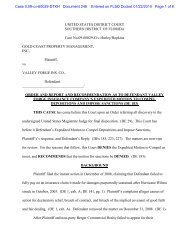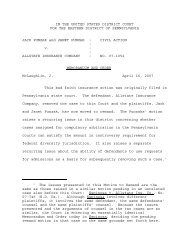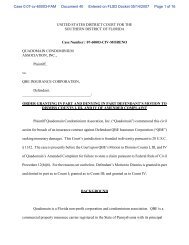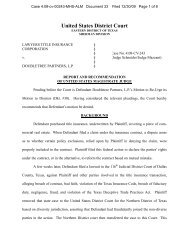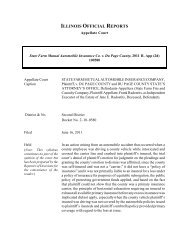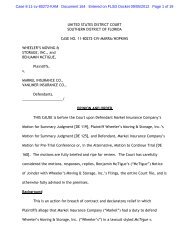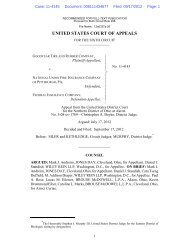Download Diamond State Insurance Co. v. His House Inc.
Download Diamond State Insurance Co. v. His House Inc.
Download Diamond State Insurance Co. v. His House Inc.
Create successful ePaper yourself
Turn your PDF publications into a flip-book with our unique Google optimized e-Paper software.
Case 1:10-cv-20039-UU Document 82 Entered on FLSD Docket 01/18/2011 Page 1 of 16<br />
UNITED STATES DISTRICT COURT<br />
SOUTHERN DISTRICT OF FLORIDA<br />
CASE NO. 10-20039-CIV-UNGARO/SIMONTON<br />
DIAMOND STATE INSURANCE<br />
COMPANY,<br />
v.<br />
Plaintiff,<br />
HIS HOUSE, INC. et al.,<br />
Defendant.<br />
/<br />
DISCOVERY ORDER ON DEFENDANT HIS HOUSE INC.’S<br />
MOTION TO COMPEL CORPORATE REPRESENTATIVE<br />
DEPOSITION, MOTION FOR PROTECTIVE ORDER<br />
AND MOTION TO QUASH SUBPOENA OF KRISTEN GLASPY<br />
Presently pending before the <strong>Co</strong>urt are Defendant <strong>His</strong> <strong>House</strong>, <strong>Inc</strong>.’s Motion to<br />
<strong>Co</strong>mpel 30(b)(6) Deposition of Plaintiff <strong>Diamond</strong> <strong>State</strong> <strong>Insurance</strong> <strong>Co</strong>mpany (DE # 44);<br />
Defendant <strong>His</strong> <strong>House</strong>, <strong>Inc</strong>’s Motion for Protective Order (DE # 49); and, Defendant <strong>His</strong><br />
<strong>House</strong>, <strong>Inc</strong>.’s Motion to Quash Subpoena of Kristen Glaspy or Alternatively for Protective<br />
Order (DE # 51). The Motions have been fully briefed (DE ## 56, 57 58, 59, 65, 66), and<br />
referred to the undersigned Magistrate Judge (DE ## 45, 50, 53).<br />
I. BACKGROUND<br />
This matter was initiated when <strong>Diamond</strong> <strong>State</strong> <strong>Insurance</strong> <strong>Co</strong>mpany (“<strong>Diamond</strong>”)<br />
filed a two count <strong>Co</strong>mplaint seeking a declaratory judgment with respect to its rights and<br />
obligations under a Professional Liability Policy (<strong>Co</strong>unt I) and a <strong>Co</strong>mmercial General<br />
Liability Policy (<strong>Co</strong>unt II) issued to <strong>His</strong> <strong>House</strong>, <strong>Inc</strong>., (“<strong>His</strong> <strong>House</strong>”) a non-profit<br />
corporation (DE # 1). The Declaratory Relief <strong>Co</strong>mplaint alleges that <strong>His</strong> <strong>House</strong>, <strong>Inc</strong>., was<br />
named as a defendant in an action filed in the Seventeenth Judicial Circuit, Broward<br />
<strong>Co</strong>unty, Florida, related to the death of an infant placed at <strong>His</strong> <strong>House</strong> following removal
Case 1:10-cv-20039-UU Document 82 Entered on FLSD Docket 01/18/2011 Page 2 of 16<br />
of the child by the Department of Children and Families-Broward (DCF) from the home of<br />
her mother (DE # 1 at 7-13). That action alleges that the infant M.C. was found<br />
deceased on February 15, 2007, some time after being wrapped in a blanket by Kristen<br />
Glaspy, the foster care mother who was employed by <strong>His</strong> <strong>House</strong> (DE # 1 15, 18, 20).<br />
The state action, which alleges wrongful death, was brought against <strong>His</strong> <strong>House</strong> by the<br />
Estate of the minor decedent and the natural parents of the child, Jossalyn D. Crawford<br />
and Michael <strong>Co</strong>ley as Personal Representatives of the Estate (DE # 11 at 7). According<br />
to the <strong>Co</strong>mplaint in this action, Defendant <strong>His</strong> <strong>House</strong> sought coverage in the wrongful<br />
death action from <strong>Diamond</strong> pursuant to the Professional Liability Policy and a<br />
<strong>Co</strong>mmercial General Liability Policy issued by <strong>Diamond</strong> to <strong>His</strong> <strong>House</strong>. In addition, <strong>His</strong><br />
<strong>House</strong> sought coverage from Lexington <strong>Insurance</strong> <strong>Co</strong>mpany (Lexington) which also<br />
issued a general coverage liability policy to <strong>His</strong> <strong>House</strong> (DE # 1 46, 47). Lexington is<br />
currently providing a defense to <strong>His</strong> <strong>House</strong> in the state action, but <strong>Diamond</strong> denied <strong>His</strong><br />
<strong>House</strong>’s request for coverage in that action (DE # 1 47, 48).<br />
<strong>Diamond</strong> now seeks a declaration from this <strong>Co</strong>urt that it has no duty to defend or<br />
indemnify <strong>His</strong> <strong>House</strong> for the claims brought in state court under either the Professional<br />
Liability Policy or the <strong>Co</strong>mmercial General Liability Policy. <strong>Diamond</strong> has named <strong>His</strong><br />
<strong>House</strong>, and the natural Parents a Personal Representatives of the infant’s Estate as<br />
defendants in this action. <strong>Diamond</strong> alleges that under the Professional Liability Policy,<br />
<strong>Diamond</strong> does not owe a duty to defend nor indemnify <strong>His</strong> <strong>House</strong> because the actions<br />
which allegedly resulted in the death of the infant do not qualify as a “professional<br />
social services” and thus are not a “wrongful act” under that policy (DE # 1 50-55). In<br />
addition, <strong>Diamond</strong> alleges that <strong>His</strong> <strong>House</strong> knew of the death of the infant prior to June<br />
30, 2008, the date that the application for the professional liability policy was completed,<br />
2
Case 1:10-cv-20039-UU Document 82 Entered on FLSD Docket 01/18/2011 Page 3 of 16<br />
and could have reasonably foreseen that a claim would be brought against <strong>His</strong> <strong>House</strong><br />
prior to signing the application, and thus no coverage is available under that policy (DE #<br />
1<br />
1 at 65-70). Similarly, <strong>Diamond</strong> alleges that it does not have a duty to defend and/or<br />
indemnify <strong>His</strong> <strong>House</strong> under the <strong>Co</strong>mmercial General Liability Policy because the injury to<br />
the infant occurred prior to the policy period and thus no coverage is available under<br />
that policy either (DE # 1 at 80-86).<br />
<strong>His</strong> <strong>House</strong> has filed an Answer and Affirmative Defenses (DE # 10). In the Answer,<br />
<strong>His</strong> <strong>House</strong> responds to many of <strong>Diamond</strong>’s allegations regarding coverage under the<br />
Professional Liability Policy by stating, “The Professional Liability Policy speaks for<br />
itself, otherwise denied.” (DE # 10 at 50, 51, 54, 55, 56, 57, 58, 64). Similarly, <strong>His</strong><br />
<strong>House</strong> responds to many of <strong>Diamond</strong>’s allegations regarding coverage under the<br />
<strong>Co</strong>mmercial General Liability Policy by stating, “The <strong>Co</strong>mmercial General Liability Policy<br />
speaks for itself, otherwise denied.” (DE # 10 at 77, 78, 79, 80, 84). Further, it its<br />
Affirmative Defenses, <strong>His</strong> <strong>House</strong> asserts that the action should be stayed pending<br />
resolution of underlying state action because <strong>Diamond</strong>’s declaratory action is premature<br />
(DE # 10 at 8).<br />
The Parents as Personal Representatives of the infant and the Estate of the infant<br />
have filed an Answer and Affirmative defenses wherein those Parties generally assert,<br />
inter alia, that the policies at issue are ambiguous (DE # 29 at 5).<br />
1<br />
<strong>Diamond</strong> also asserts that under these facts, if any coverage were required by<br />
<strong>Diamond</strong>, it would only be as an excess insurer because <strong>His</strong> <strong>House</strong> held a separate<br />
policy with Lexington and thus pursuant to the terms of <strong>Diamond</strong>’s policy, coverage only<br />
exists for liability beyond that covered by other policies with other insurers (DE # 1 at <br />
39, 56, 60, 61, 62, 63, 72).<br />
3
Case 1:10-cv-20039-UU Document 82 Entered on FLSD Docket 01/18/2011 Page 4 of 16<br />
II.<br />
LAW & ANALYSIS<br />
A. Framework for Analysis<br />
Federal Rule of Civil Procedure 26 (b)(1), provides in relevant part, “Parties may<br />
obtain discovery regarding any nonprivileged matter that is relevant to any party’s claim<br />
or defense,” and further states, “Relevant information need not be admissible at trial if<br />
the discovery appears reasonably calculated to lead to the discovery of admissible<br />
evidence.” In addition, Rule 26(c), which addresses protective orders, provides that the<br />
court may, for good cause, issue an order to protect a party from annoyance,<br />
embarrassment, oppression or undue burden or expense.<br />
Under Florida law, which governs the substantive portions of this declaratory<br />
action, the construction of an insurance policy is a question of law to be determined by<br />
the court. E.g., Jones v. Utica Mut. Ins. <strong>Co</strong>., 463 So.2d 1153, 1157 (Fla. 1985); <strong>State</strong> Farm<br />
Fire & Cas. <strong>Co</strong>. v. Castillo, 829 So.2d 242, 244 (Fla. Dist. Ct. App. 2002). An unambiguous<br />
insurance contract must be construed according to its plain terms, without resorting to<br />
extrinsic evidence. See Taurus Holdings, <strong>Inc</strong>. v. U.S. Fidelity and Guar. <strong>Co</strong>., 913 So.2d<br />
528, 532 (Fla. 2005). However, if, after construing the policy, the court finds that more<br />
than one interpretation is possible, it must resolve the ambiguity against the insurer who<br />
drafted the language of the insurance contract. Auto-Owners Ins. <strong>Co</strong>. v. Anderson, 756<br />
So. 2d 29, 34 (Fla. 2000); See also Travelers Ins. <strong>Co</strong>. v. Smith, 328 So. 2d 870 (Fla. Dist.<br />
Ct. App. 1976). In sum, if the policy provisions at issue are unambiguous, they will be<br />
enforced as written; and, if the policy provisions are ambiguous, they must be construed<br />
strictly against Plaintiff and in favor of Defendants. See Allstate Ins. <strong>Co</strong>. v. Swain, 921<br />
So.2d 717, 719 (Fla. Dist. Ct. App. 2006) (quashing orders which compelled discovery<br />
concerning, inter alia, drafting, marketing and interpretation of insurance policy, holding<br />
4
Case 1:10-cv-20039-UU Document 82 Entered on FLSD Docket 01/18/2011 Page 5 of 16<br />
that construction of policy is a matter of law and if it is ambiguous, the ambiguity will be<br />
resolved against the insurer; therefore, the requested discovery was “completely<br />
unnecessary to the determination of the coverage issue.”); Accord Deni Assoc. of<br />
Florida, <strong>Inc</strong>. v. <strong>State</strong> Farm Fire & Cas. Ins. <strong>Co</strong>., 711 So. 2d 1135 (Fla. 1998).<br />
In addition, an insurer's duty to defend an insured is determined from the<br />
allegations of the complaint brought against the insured. Nat'l Union Fire Ins. <strong>Co</strong>. v.<br />
Lenox Liquors, 358 So.2d 533 (Fla. 1977); <strong>State</strong> Farm Mutual Automobile <strong>Insurance</strong> <strong>Co</strong>. v.<br />
Culver, 576 So.2d 918 (Fla. Dist. Ct. App. 1991); C.A. Fielland, <strong>Inc</strong>. v. Fidelity & Casualty<br />
<strong>Co</strong>. of New York, 297 So.2d 122 (Fla. Dist. Ct. App. 1974), cert. denied, 309 So.2d 6 (Fla.<br />
1975). Further, the duty to indemnify is narrower than the duty to defend and thus<br />
cannot exist if there is no duty to defend. See Aetna Ins. <strong>Co</strong>. v. Borrell-Bigby Elec. <strong>Co</strong>.,<br />
541 So.2d 139, 141 (Fla. Dist. Ct. App. 1989) (“Florida recognizes that the duty to defend<br />
an insured is broader than the duty to indemnify.”); Fun Spree Vacations, <strong>Inc</strong>. v. Orion<br />
Ins. <strong>Co</strong>., 659 So.2d 419, 421 (Fla. Dist. Ct. App. 1995). However, a duty to indemnify is<br />
“not determined by mere allegations but by the facts” in the underlying tort action<br />
adduced at trial or developed through discovery during the litigation. Traveler's<br />
Indemnity <strong>Co</strong>. v. Royal Oak Enterprises, <strong>Inc</strong>., 344 F. Supp.2d 1358, 1368 (M.D. Fla. 2004).<br />
B. Defendant <strong>His</strong> <strong>House</strong>, <strong>Inc</strong>’s Motion to <strong>Co</strong>mpel 30(b)(6) Deposition of<br />
Plaintiff <strong>Diamond</strong> <strong>State</strong> <strong>Insurance</strong> <strong>Co</strong>mpany (DE # 44)<br />
In this Motion, Defendant <strong>His</strong> <strong>House</strong> seeks to compel <strong>Diamond</strong> <strong>State</strong> <strong>Insurance</strong><br />
<strong>Co</strong>mpany to produce a corporate representative for deposition pursuant to Federal Rule<br />
of Civil Procedure 30 (b)(6). <strong>His</strong> <strong>House</strong> asserts that it seeks to depose <strong>Diamond</strong> <strong>State</strong>’s<br />
corporate representative about the (1) policies at issue in this cause; (2) the issuance<br />
and procurement of the policies, including <strong>Diamond</strong> <strong>State</strong>’s underwriting considerations<br />
5
Case 1:10-cv-20039-UU Document 82 Entered on FLSD Docket 01/18/2011 Page 6 of 16<br />
in issuing the policies and setting the premiums; (3) <strong>Diamond</strong> <strong>State</strong>’s interpretation of<br />
the policies, which interpretations their declaratory action is based on; (4) <strong>His</strong> <strong>House</strong>’s<br />
application for the insurance policies and all information disclosed therein and in the<br />
overall application process, including the potential liability for the claim giving rise to<br />
this action; and (5) <strong>Diamond</strong> <strong>State</strong>’s handling of <strong>His</strong> <strong>House</strong>’s claim and ultimate denial<br />
thereof. (DE # 44 at 5). <strong>His</strong> <strong>House</strong> argues that the deposition examination topics are<br />
relevant to the instant action and therefore, with the exception of any assertions of<br />
privilege, are discoverable.<br />
In Response, <strong>Diamond</strong> asserts that the deposition topics identified by <strong>His</strong> <strong>House</strong><br />
are not relevant to the current action because actions seeking an interpretation of an<br />
insurance contract are a matter of law and are resolved by the <strong>Co</strong>urt through the plain<br />
language of the contract. Thus, <strong>Diamond</strong> asserts that the interpretation of the policy by<br />
<strong>Diamond</strong>’s corporate representative is not relevant. Further, <strong>Diamond</strong> argues that <strong>His</strong><br />
<strong>House</strong>’s request is akin to bad faith discovery which is impermissible as premature<br />
during the resolution of a coverage action, and also objects to the extent that <strong>His</strong> <strong>House</strong><br />
seeks to discover privileged information.<br />
In its Reply, <strong>His</strong> <strong>House</strong> argues that because the policies at issue are ambiguous,<br />
extrinsic evidence may be considered by the <strong>Co</strong>urt, and thus the testimony of the<br />
Defendant’s <strong>Co</strong>rporate Representative regarding policy interpretation is relevant.<br />
Specifically, <strong>His</strong> <strong>House</strong> asserts that the terms “professional social service”, “wrongful<br />
act” and “claims” are all ambiguous. <strong>His</strong> <strong>House</strong> also contends that it has not asserted a<br />
bad faith claim in connection with <strong>Diamond</strong>’s denial of coverage, but nevertheless<br />
contends that <strong>Diamond</strong>’s corporate representative’s interpretation of the policy is<br />
relevant to this action.<br />
6
Case 1:10-cv-20039-UU Document 82 Entered on FLSD Docket 01/18/2011 Page 7 of 16<br />
For the following reasons, in light of the applicable law set forth above, the<br />
undersigned concludes that deposition testimony of <strong>Diamond</strong>’s corporate representative<br />
on the topics identified by <strong>His</strong> <strong>House</strong> are irrelevant to the resolution of this declaratory<br />
action. First, if the <strong>Co</strong>urt determines that the language of the Professional Liability<br />
Policy and the <strong>Co</strong>mmercial General Liability Policy are unambiguous, then the <strong>Co</strong>urt will<br />
resolve the dispute about coverage based upon the plain language of those policies<br />
without resort to extrinsic evidence, including any interpretation by <strong>Diamond</strong>’s corporate<br />
representative regarding the language or terms of the policies. Second, in the event that<br />
the <strong>Co</strong>urt determines the policy language is ambiguous, Defendants will automatically<br />
prevail in the instant declaratory action. See Koikos v. Travelers Ins. <strong>Co</strong>., 849 So.2d 263,<br />
271 (Fla. 2003); Deni Assoc. of Florida, <strong>Inc</strong>. v. <strong>State</strong> Farm Fire & Cas. Ins. <strong>Co</strong>., 711 So.2d<br />
1135 (Fla. 1998) (rejecting doctrine of “reasonable expectations,” stating, “There is no<br />
need for it if the policy provisions are ambiguous because in Florida ambiguities are<br />
construed against the insurer [and t]o apply the doctrine to an unambiguous provision<br />
would be to rewrite the contract ....”). Thus, under either scenario, the testimony of<br />
<strong>Diamond</strong>’s corporate representative is irrelevant. Medmarc Casualty Ins. <strong>Co</strong>. v. Ventura,<br />
2008 WL 4371311 *3 (S.D. Fla. Sept. 18, 2008) (finding corporate representative’s<br />
deposition testimony regarding interpretation of insurance policy irrelevant).<br />
In addition, <strong>His</strong> <strong>House</strong> correctly notes that there has been no bad-faith claim<br />
raised in the instant action, nor are there allegations related to misrepresentation or<br />
fraud either of which might well necessitate deposing <strong>Diamond</strong>’s corporate<br />
representative. Rather, in this action the only issue is whether there is coverage under<br />
the relevant policies or if, based upon the plain language of those policies, coverage, in<br />
the form of defending or indemnifying the insured, exists.<br />
7
Case 1:10-cv-20039-UU Document 82 Entered on FLSD Docket 01/18/2011 Page 8 of 16<br />
One other issue raised in the pleadings merits discussion. In its <strong>Co</strong>mplaint,<br />
Plaintiff <strong>Diamond</strong> has alleged that <strong>His</strong> <strong>House</strong> knew of the death of the infant prior to<br />
June 30, 2008, the date that the application for the Professional Liability Policy was<br />
completed and could have reasonably foreseen that a claim would be brought against<br />
<strong>His</strong> <strong>House</strong> prior to signing the application, and thus no coverage is available under that<br />
policy (DE # 1 at 65-70). Similarly, <strong>Diamond</strong> has alleged that the death of the infant<br />
occurred prior to the <strong>Co</strong>mmercial General Liability policy issued for the policy period of<br />
June 30, 2008 to June 30, 2009, and thus no coverage is available under that policy either<br />
(DE # 1, 80-82). <strong>His</strong> <strong>House</strong> argues that because of these allegations, <strong>Diamond</strong> has<br />
made “<strong>His</strong> <strong>House</strong>’s knowledge the cornerstone of its declaratory action.” (DE # 44 at 6).<br />
As such, <strong>His</strong> <strong>House</strong> asserts that <strong>Diamond</strong>’s underwriting considerations when the<br />
policies were issued are relevant and necessitate that <strong>His</strong> <strong>House</strong> be allowed to depose<br />
<strong>Diamond</strong>’s <strong>Co</strong>rporate Representative on matters relevant to that issue, including the<br />
“issuance and procurement of the policies, including <strong>Diamond</strong> <strong>State</strong>’s underwriting<br />
consideration in issuing the policies and setting the premiums.” (DE # 44 at 5).<br />
However, the date that <strong>His</strong> <strong>House</strong> become aware of the death of the infant and/or<br />
a potential claim related to the death is not contested by <strong>His</strong> <strong>House</strong> (DE # 10 at 66, 69,<br />
83), and more importantly, is not altered by <strong>Diamond</strong> <strong>State</strong>’s underwriting considerations<br />
or application process. In other words, given that there are no allegations that the dates<br />
applicable to coverage under the policy are ambiguous, then the policies will be<br />
construed according to their to plain terms, without resorting to extrinsic evidence. And,<br />
again, to the extent that there are any ambiguities, those ambiguities would be<br />
construed against <strong>Diamond</strong>. As such, it is not relevant in this declaratory judgment<br />
action, which only seeks a determination of whether there is a duty to defend or a duty<br />
8
Case 1:10-cv-20039-UU Document 82 Entered on FLSD Docket 01/18/2011 Page 9 of 16<br />
to indemnify, what considerations <strong>Diamond</strong> made in issuing the insurance policies to<br />
<strong>His</strong> <strong>House</strong>.<br />
Further, Defendant’s reliance on D’Aprile v. Unum Life Ins. <strong>Co</strong>., 2010 WL 3340197<br />
(M.D. Fla., 2010) for support of its position, is misplaced. D’Aprile is distinguishable<br />
from the case at bar because although the case involved a breach of contract action, it<br />
was not in the context of a “duty to defend” or “duty to indemnify” declaratory action.<br />
This distinction is significant because a breach of contract action may contemplate more<br />
than the interpretation of the plain language and may reach to other duties and/or<br />
obligations under the policy. Thus, a breach of an insurance contract claim may require<br />
discovery into claims handling information, guidelines, etc., for purposes of discovering<br />
whether a breach of contract actually occurred. In D’Aprile for example, the court<br />
determined that the defendant insurer’s policy and practices related to the insurer’s<br />
denial of benefits based upon the insurer’s finding that plaintiff did not suffer from<br />
restrictions and limitations that restricted her ability to perform her occupation. Id. at * 3-<br />
4. Thus, the claims raised in that case exceeded the policy coverage issues made in this<br />
action which arise from the plain language of the policy.<br />
In this regard, this case is more akin to Allstate Ins. <strong>Co</strong>., v. Swain, 921 So. 2d 717<br />
(Fla. Dist. Ct. App. 2006), wherein the state appellate court reversed the trial court’s<br />
order that the insurer produce information and documents regarding the drafting,<br />
marketing, and interpretation of its umbrella policies. The appellate court concluded<br />
that such information was completely unnecessary to the determination of the coverage<br />
issue presented in that case and held that the insurer should therefore not be required to<br />
comply with the discovery requests.<br />
Thus, although the undersigned is aware that the threshold for determining<br />
9
Case 1:10-cv-20039-UU Document 82 Entered on FLSD Docket 01/18/2011 Page 10 of 16<br />
whether discovery is relevant is relatively low, the “proponent of a motion to compel<br />
discovery [still] bears the initial burden of proving that the information sought is<br />
relevant.” Peacock v. Merrill, 2008 WL 176375 *8 (S.D. Ala. Jan. 17, 2008) citing West v.<br />
Miller, 2006 WL 2349988 (2006); Alexander v. Federal Bureau of Investigation, 186 F.R.D.<br />
154, 159 (D.D.C. 1999) (“[T]he proponent of a motion to compel discovery bears the initial<br />
burden of proving that the information sought is relevant.”). Under the facts of this<br />
declaratory judgment action, the undersigned concludes that <strong>His</strong> <strong>House</strong> has not shown<br />
that the deposition topics are relevant to the resolution of this action, and thus <strong>His</strong><br />
<strong>House</strong> is not entitled to depose the Plaintiff’s corporate representative. See generally,<br />
<strong>Co</strong>mmercial Union Ins. <strong>Co</strong>. v. Westrope, 730 F.2d 729, 732 (11th Cir. 1984) (holding court<br />
can deny a motion to compel further discovery if court finds questions are irrelevant).<br />
Accordingly, based upon the failure of <strong>His</strong> <strong>House</strong> to show how the testimony<br />
sought would be relevant to the claims and issues currently before the court in this<br />
action, <strong>His</strong> <strong>House</strong>’s Motion to <strong>Co</strong>mpel the deposition of <strong>Diamond</strong>’s corporate<br />
representative is denied.<br />
C. Defendant <strong>His</strong> <strong>House</strong>, <strong>Inc</strong>.’s Motion for Protective Order (DE # 49);<br />
Defendant <strong>His</strong> <strong>House</strong>, <strong>Inc</strong>.’s Motion to Quash Subpoena of Kristen<br />
Glaspy or Alternatively for Protective Order (DE # 51)<br />
In these two Motions, Defendant <strong>His</strong> <strong>House</strong> seeks to limit discovery sought by<br />
Plaintiff <strong>Diamond</strong> related to conducting a 30(b)(6) deposition of <strong>His</strong> <strong>House</strong>’s corporate<br />
representative and deposing one of <strong>His</strong> <strong>House</strong>’s employees, Kristen Glaspy.<br />
In the Motion for Protective Order, <strong>His</strong> <strong>House</strong> asserts that the Notice of Taking<br />
30(b)(6) Deposition issued by <strong>Diamond</strong> identifies 13 categories of topics to be covered at<br />
the deposition, many of which, according to <strong>His</strong> <strong>House</strong>, are not relevant to the claims or<br />
defenses raised in this action and/or were already testified to either through admissions<br />
10
Case 1:10-cv-20039-UU Document 82 Entered on FLSD Docket 01/18/2011 Page 11 of 16<br />
or in the underlying state action. Specifically, <strong>His</strong> <strong>House</strong> argues that its corporate<br />
representative, Liliana Ganuza was already deposed in the underlying state action and<br />
testified as to the following subjects:<br />
1. The death of the infant;<br />
2. <strong>His</strong> <strong>House</strong>’s investigation of the death of the infant;<br />
3. The Report completed by <strong>His</strong> <strong>House</strong> in connection with the death of<br />
the infant;<br />
4. <strong>His</strong> <strong>House</strong>’s communications with other agency defendants<br />
regarding the death of the infant;<br />
5. The handling of the infant’s case; and,<br />
6. The police and medical examiner reports regarding the death of the<br />
infant.<br />
(DE # 49 at 3). Further, <strong>His</strong> <strong>House</strong> asserts that the same corporate representative was<br />
produced and testified in a deposition on November 30, 2010 in this action on the<br />
following topics:<br />
1. Any inquiries, claims, demands and suit made by the Personal<br />
Representative to or against <strong>His</strong> <strong>House</strong> regarding the death of the<br />
infant;<br />
2. Any inquiries, claims, or communication <strong>His</strong> <strong>House</strong> had with any of<br />
its insurance companies or agents pertaining to the death of the<br />
infant, including its conversations with the agent who procured the<br />
Policies; and<br />
3. Any reports or investigation by <strong>His</strong> <strong>House</strong> or of which <strong>His</strong> <strong>House</strong><br />
had first-hand knowledge related to the death of the infant.<br />
(DE # 49 at 6). Thus, <strong>His</strong> <strong>House</strong> contends that almost all of the topics listed in<br />
<strong>Diamond</strong>’s 30(b)(6) Notice have already been testified to by <strong>His</strong> <strong>House</strong>’s corporate<br />
representative in either this action or the underlying action.<br />
Similarly in the Motion for Protective Order and the Motion to Quash Subpoena of<br />
11
Case 1:10-cv-20039-UU Document 82 Entered on FLSD Docket 01/18/2011 Page 12 of 16<br />
Kristen Glaspy or Alternatively for Protective Order, <strong>His</strong> <strong>House</strong> asserts that Kristen<br />
Glaspy, the <strong>His</strong> <strong>House</strong> employee assigned as the house parent on duty during the time<br />
that the infant died, was deposed in the underlying action wherein she testified<br />
regarding the care of the infant and the events surrounding the infant’s death. <strong>His</strong><br />
<strong>House</strong> therefore argues that much of the information sought by <strong>Diamond</strong> from the<br />
<strong>Co</strong>rporate Representative and Ms. Glaspy related to the facts surrounding the infant’s<br />
care and death is duplicative and cumulative.<br />
In addition, <strong>His</strong> <strong>House</strong> asserts that much of the information sought by <strong>Diamond</strong> is<br />
irrelevant to this declaratory action. Specifically, <strong>His</strong> <strong>House</strong> argues that the testimony<br />
related to the employment history or performance of the foster mother, Kristen Glaspy is<br />
not relevant to this action, and further that the care of the infant and the events<br />
surrounding his death are not relevant to resolving the declaratory action.<br />
<strong>His</strong> <strong>House</strong> also asserts that several of the deposition topics identified in the<br />
30(b)(6) Notice are overlybroad as drafted because they do not limit the requested<br />
information to the parties or claims involved in this action. Finally, <strong>His</strong> <strong>House</strong> asserts<br />
that lay witness testimony is not appropriate regarding the cause of death of the infant,<br />
which has not yet been determined in the state action.<br />
Plaintiff <strong>Diamond</strong> counters, in response to both the Motion for Protective Order<br />
and Motion to Quash, that the topics identified in the Deposition Notice are relevant to<br />
this declaratory action as they seek information regarding <strong>His</strong> <strong>House</strong>’s knowledge<br />
related to the care and events surrounding the death of the infant and the<br />
communications between <strong>His</strong> <strong>House</strong> and its insurance carriers (DE # # 56 at 6, 59 at 7).<br />
Also, <strong>Diamond</strong> argues that Kristen’s Glaspy’s qualifications and training are relevant to<br />
the declaratory action because those issues bear on whether “professional services”<br />
12
Case 1:10-cv-20039-UU Document 82 Entered on FLSD Docket 01/18/2011 Page 13 of 16<br />
were provided to the infant for purposes of determining coverage under the applicable<br />
policies (DE ## 56 at 7, 59 at 9). <strong>Diamond</strong> further asserts that the depositions are<br />
necessary because <strong>His</strong> <strong>House</strong> has refused to respond appropriately to <strong>Diamond</strong>’s<br />
Interrogatories and Requests for Admission.<br />
Based upon a review of the record as a whole, for the following reasons, the<br />
undersigned finds that <strong>Diamond</strong> is entitled to conduct the deposition of <strong>His</strong> <strong>House</strong>’s<br />
corporate representative, Liliana Ganuza, as well as the deposition of Kristen Glaspy,<br />
albeit on a limited basis. First, it is indisputable that matters related to or central to the<br />
resolution of claims and defenses raised by the Parties in this declaratory action are<br />
discoverable. Therefore information which may shed light on the nature or the services<br />
provided by <strong>His</strong> <strong>House</strong> are particularly germane to resolving the issue of coverage under<br />
the applicable policies and thus are relevant and discoverable in this action. In addition,<br />
as stated above, in the “duty to indemnify” context, the facts of the underlying tort<br />
action adduced at trial or developed in discovery are central to the resolution of that<br />
claim. Traveler's Indemnity <strong>Co</strong>. v. Royal Oak Enterprises, <strong>Inc</strong>., 344 F. Supp.2d 1358, 1368<br />
(M.D. Fla. 2004). Thus, facts related to the underlying tort action, and specifically the<br />
circumstances surrounding the death of the infant, are also relevant to resolving the<br />
“duty to indemnify” claim and are discoverable in this action.<br />
Further, the <strong>Co</strong>urt notes that Plaintiff <strong>Diamond</strong> is not a party in the underlying<br />
state action and is not providing a defense for <strong>His</strong> <strong>House</strong> in that action, and thus was not<br />
present for the depositions of either Kristen Glaspy or <strong>His</strong> <strong>House</strong>’s corporate<br />
representative taken in that matter. Thus, although the undersigned agrees that<br />
additional testimony provided by <strong>His</strong> <strong>House</strong>’s corporate representative and Ms. Glaspy<br />
will likely overlap and be largely duplicative of the testimony given in the underlying<br />
13
Case 1:10-cv-20039-UU Document 82 Entered on FLSD Docket 01/18/2011 Page 14 of 16<br />
state action, because <strong>Diamond</strong> was not able to ask questions in those depositions, and<br />
testimony from those witnesses may be relevant to the resolution of this matter,<br />
<strong>Diamond</strong> should have an opportunity to depose the witnesses on those issues. These<br />
depositions will be severely limited in duration however, since <strong>Diamond</strong> only needs to<br />
fill in the gaps left by the prior deposition. Finally, <strong>His</strong> <strong>House</strong> has failed to demonstrate<br />
that allowing <strong>Diamond</strong> to conduct depositions of the corporate representative or Ms.<br />
Glaspy is unduly prejudice or will result in undue hardship, burden or expense. The<br />
<strong>Co</strong>urt notes however, that to the extent that <strong>Diamond</strong> complains that <strong>His</strong> <strong>House</strong>’s written<br />
responses to <strong>Diamond</strong>’s discovery requests were inadequate, <strong>Diamond</strong> has failed to file<br />
a motion to compel or seek other relief from the <strong>Co</strong>urt regarding that issue, thus the<br />
<strong>Co</strong>urt does not address those claims.<br />
Therefore, the <strong>Co</strong>urt concludes that a brief further deposition of Ms. Ganuza and a<br />
deposition of Ms. Glaspy are warranted. On or before Friday, January 21, 2011, <strong>Diamond</strong><br />
may conduct a one hour deposition of <strong>His</strong> <strong>House</strong>’s 30(b)(6) representative on the<br />
following limited topics:<br />
1. The provision of care and services by <strong>His</strong> <strong>House</strong> to the infant;<br />
2. The events surrounding the death of the Infant;<br />
3. <strong>His</strong> <strong>House</strong>’s investigation of the death of the infant;<br />
4. <strong>Insurance</strong> Policies held by <strong>His</strong> <strong>House</strong> which may provide coverage related<br />
to the death of the infant.<br />
In addition, on or before Friday, January 21, 2011, <strong>Diamond</strong> will be permitted to conduct<br />
a one hour deposition of <strong>His</strong> <strong>House</strong> employee, Kristen Glaspy on the following topics:<br />
1. Qualifications training and education of Ms. Glaspy and the nature of<br />
services that she provided at <strong>His</strong> <strong>House</strong> and to the infant specifically;<br />
2. The events leading up to and surrounding the death of the infant.<br />
14
Case 1:10-cv-20039-UU Document 82 Entered on FLSD Docket 01/18/2011 Page 15 of 16<br />
Defendant <strong>His</strong> <strong>House</strong> shall use its best efforts in making its corporate representative and<br />
Ms. Kristen Glaspy available for deposition on or before the date set forth in this Order.<br />
If <strong>Diamond</strong> believes that additional time is needed in either scheduling the depositions<br />
and or in completing the depositions, <strong>Co</strong>unsel for <strong>Diamond</strong> shall confer with <strong>Co</strong>unsel for<br />
<strong>His</strong> <strong>House</strong> to reach a mutually agreeable time for the Parties to place a conference call to<br />
the chambers of the undersigned on or before the close of business on Thursday,<br />
January 20, 2011 for a telephonic hearing on the issue, and immediately contact<br />
chambers of the undersigned regarding same.<br />
III.<br />
CONCLUSION<br />
Therefore, based upon a review of the record as a whole, and for the reasons<br />
stated above, it is<br />
ORDERED AND ADJUDGED that Defendant <strong>His</strong> <strong>House</strong>, <strong>Inc</strong>’s Motion to <strong>Co</strong>mpel<br />
30(b)(6) Deposition of Plaintiff <strong>Diamond</strong> <strong>State</strong> <strong>Insurance</strong> <strong>Co</strong>mpany (DE # 44) is DENIED.<br />
It is further<br />
ORDERED AND ADJUDGED that Defendant <strong>His</strong> <strong>House</strong>, <strong>Inc</strong>’s Motion for<br />
Protective Order (DE # 49) and, Defendant <strong>His</strong> <strong>House</strong>, <strong>Inc</strong>.’s Motion to Quash Subpoena<br />
of Kristen Glaspy or Alternatively for Protective Order (DE # 51) are GRANTED, in part.<br />
Although <strong>His</strong> <strong>House</strong> must produce a (30)(b)(6) corporate representative and Ms. Kristen<br />
Glaspy for deposition, the topics of inquiry and the length of the depositions are limited<br />
as set forth in this Order. In addition, during the depositions, Defendant <strong>His</strong> <strong>House</strong> may<br />
15
Case 1:10-cv-20039-UU Document 82 Entered on FLSD Docket 01/18/2011 Page 16 of 16<br />
raise privilege objections, if appropriate.<br />
DONE AND ORDERED in chambers in Miami, Florida on January 18, 2011.<br />
ANDREA M. SIMONTON<br />
UNITED STATES MAGISTRATE JUDGE<br />
<strong>Co</strong>pies furnished via CM/ECF to:<br />
All counsel of record<br />
16


